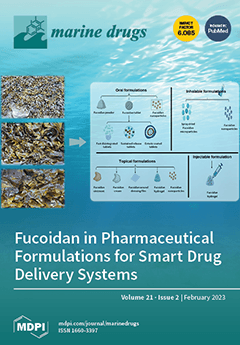Antarctic krill (
Euphausia superba) of the
Euphausiidae family comprise one of the largest biomasses in the world and play a key role in the Antarctic marine ecosystem. However, the study of
E. superba-derived microbes and their secondary metabolites has been limited. Chemical investigation of the secondary metabolites of the actinomycetes
Nocardiopsis sp. LX-1 (in the family of
Nocardiopsaceae), isolated from
E. superba, combined with molecular networking, led to the identification of 16 compounds
a–
p (purple nodes in the molecular network) and the isolation of one new pyrroline, nocarpyrroline A (
1), along with 11 known compounds
2–
12. The structure of the new compound
1 was elucidated by extensive spectroscopic investigation. Compound
2 exhibited broad-spectrum antibacterial activities against
A. hydrophila,
D. chrysanthemi,
C. terrigena,
X. citri pv. malvacearum and antifungal activity against
C. albicans in a conventional broth dilution assay. The positive control was ciprofloxacin with the MIC values of <0.024 µM, 0.39 µM, 0.39 µM, 0.39 µM, and 0.20 µM, respectively. Compound
1 and compounds
7,
10, and
11 displayed antifungal activities against
F. fujikuroi and
D. citri, respectively, in modified agar diffusion test. Prochloraz was used as positive control and showed the inhibition zone radius of 17 mm and 15 mm against
F. fujikuroi and
D. citri, respectively. All the annotated compounds
a–
p by molecular networking were first discovered from the genus
Nocardiopsis. Nocarpyrroline A (
1) features an unprecedented 4,5-dihydro-pyrrole-2-carbonitrile substructure, and it is the first pyrroline isolated from the genus
Nocardiopsis. This study further demonstrated the guiding significance of molecular networking in the research of microbial secondary metabolites.
Full article






